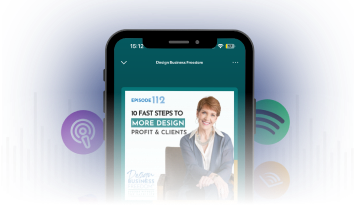Effective Design Contracts
In the world of interior design, contracts aren’t just legal documents—they’re powerful tools that can drive your business growth. Effective design contracts not only protect your profits but also ensure clarity and confidence for both you and your clients. Let’s explore how you can use well-crafted contracts to unlock your business’s full potential and create a seamless experience for your clients.
The Importance of a Well-Structured Contract
A well-structured contract, often referred to as a Letter of Agreement, is more than just a formality. It serves as a foundation for your client relationships, setting clear expectations and defining the scope of work. Without effective design contracts, you’re essentially flying without a net. This is leaving your business vulnerable to misunderstandings, scope creep, and financial losses.
✔ Protect Your Profits: Clearly outline your fees, payment terms, and what is included in the scope of work. This ensures that you are paid fairly for your services and that there are no surprises for your clients.
✔ Provide Clarity: A well-drafted contract eliminates ambiguity by clearly defining the roles, responsibilities, and deliverables for both parties. This clarity reduces the chances of disputes and helps maintain a positive client relationship.

Making Contracts User-Friendly
One common reason designers hesitate to use detailed contracts is that they can seem intimidating or overly complex to clients. However, effective design contracts don’t have to be filled with legal jargon. By making your contracts more user-friendly, you can create a more pleasant process for your clients and increase your chances of closing deals.
✔ Simplify the Language: Avoid using complicated legal terms and instead, write your contract in plain English. This makes it easier for clients to understand and more likely that they’ll sign without hesitation.
✔ Use Visual Elements: Incorporate visual elements into your contract. These can be your brand colors, photos of your work, and even a friendly cover page. Tools like Proposify allow you to create visually appealing contracts that feel more like an invitation to collaborate rather than a legal document.
Key Clauses to Include in Your Contract
To ensure your contracts are as effective as possible, there are several key clauses that you should always include. These clauses protect your business, provide clear guidelines for your clients, and help prevent common issues that arise during the design process.
✔ Scope of Work: Detail the specific services you will provide, using the client’s language to describe each room or project area. This helps the client feel understood and ensures there are no misunderstandings about what’s included.
✔ Timeline and Deadlines: Exact timelines can be challenging to pin down due to variables like product availability and contractor schedules. Therefore, providing an estimated timeline with key milestones helps manage client expectations.
✔ Payment Terms: Specify how and when payments are due. Whether you require a full upfront payment or installments, make sure these terms are clearly laid out to avoid any delays or disputes.
✔ Change Orders: Include a clause that requires any changes to the project scope to be documented in writing, with both parties’ signatures. This protects you from scope creep and ensures you are compensated for any additional work.
✔ Intellectual Property: Protect your designs and drawings. Include a clause that states these materials are for the client’s use only in the context of the project and cannot be distributed or used elsewhere without your permission.
Walking Clients Through the Contract
Once you’ve created a comprehensive and user-friendly contract, it’s important to walk your clients through it rather than simply sending it via email. This personal touch not only helps to build trust but also ensures that clients fully understand the agreement. This happens before signing, making the process of effective design contracts even more successful.
✔ Set Up a Meeting: Schedule a meeting, either in person or via Zoom, to go over the contract with your client. This allows you to explain each section, answer any questions, and address any concerns they might have.
✔ Highlight Key Points: Focus on the most critical parts of the contract, such as the scope of work, payment terms, and timelines. Make sure these sections are clear to the client, as they are the foundation of your working relationship.
✔ Encourage Questions: Invite your clients to ask questions during the walkthrough. This not only helps clarify any uncertainties but also reinforces their confidence in you as a professional.
Key Takeaways for Effective Design Contracts
Effective design contracts are essential for the success and growth of your interior design business. Create a contract that is both comprehensive and user-friendly. You can protect your profits, provide clarity for your clients, and ensure a smooth, professional process from start to finish. Remember, your contract is not just a legal requirement. It’s a tool that can help you build stronger client relationships and unlock new levels of business growth.
If you’re ready to increase your profits, work exclusively with ideal clients, and enjoy the time and resources for your extraordinary life, explore your coaching options. We’ve got your back in business.





